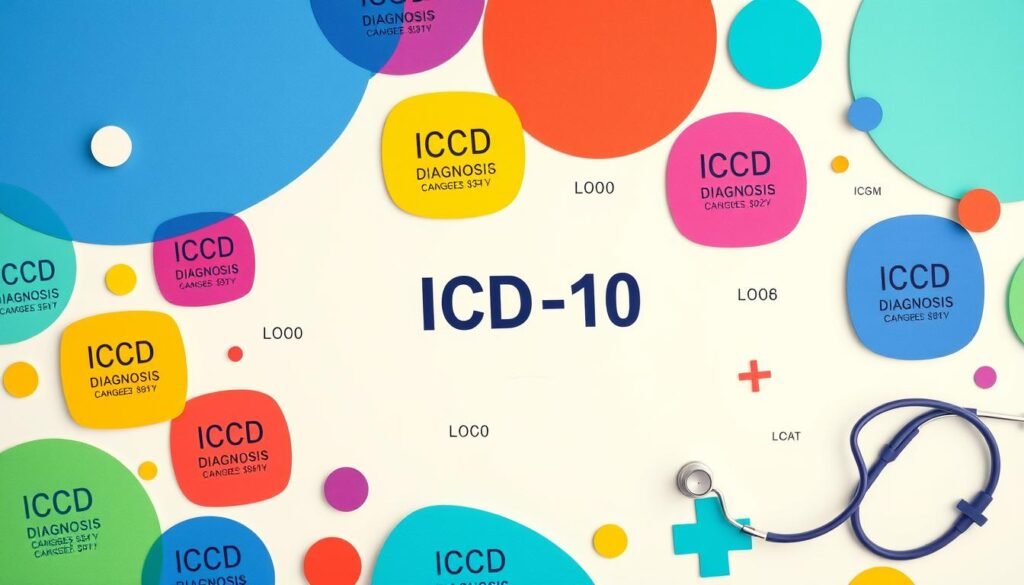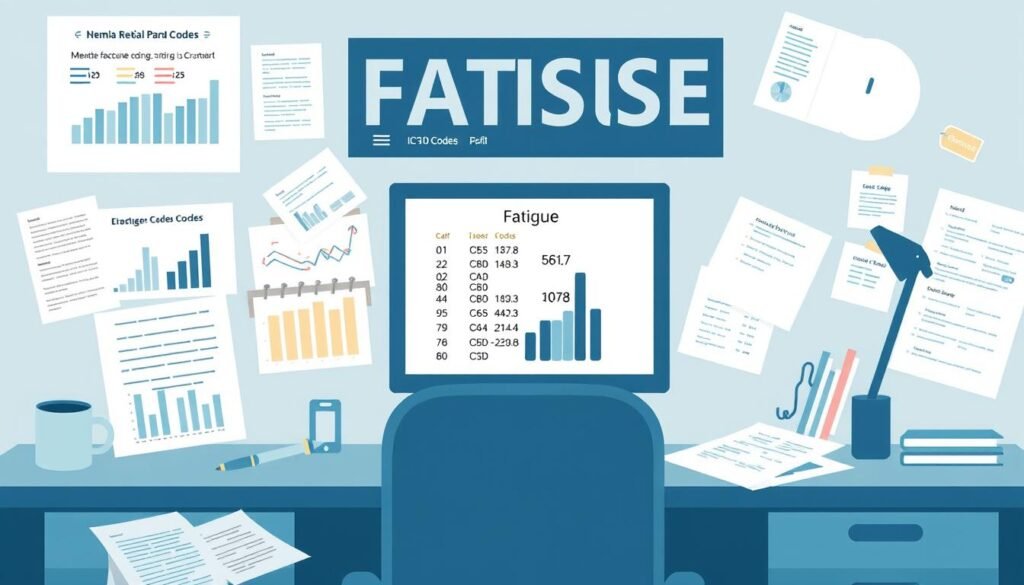Between 836,000 and 2.5 million Americans struggle with myalgic encephalomyelitis/chronic fatigue syndrome (ME/CFS). This shows how widespread fatigue is and its effect on both people and healthcare. The ICD 10 code for fatigue, especially code R53.83, is crucial. It helps with accurate diagnosis and records for fatigue cases. It’s key for managing patient care and ensuring correct payment.
Starting October 1, 2024, changes to fatigue coding will simplify how we understand fatigue-related conditions. It’s key for healthcare workers to know how to use these codes. Not just for ME/CFS but other fatigue cases too. This medical billing guide will cover everything. From new codes to documentation tips, it’s here to help healthcare pros and billers navigate fatigue coding.
Key Takeaways
- An estimated 836,000 to 2.5 million Americans experience chronic fatigue conditions.
- The ICD 10 code R53.83 is vital for accurate documentation of fatigue cases.
- New diagnostic codes, including G93.32 for ME/CFS, were introduced to enhance coding precision.
- Effective from October 1, 2024, the updates aim to improve healthcare billing practices.
- Understanding these codes aids providers in managing patient care efficiently.
- Accurate coding is essential for successful reimbursement claims.
Understanding Fatigue and Its Impact on Daily Life
Fatigue affects our daily activities and quality of life deeply. It comes from many sources, such as lifestyle, health issues, and mental conditions. Knowing about fatigue helps us find the right treatments.
Fatigue does more than just make you feel tired. It lowers your productivity and affects thinking. It makes doing personal and work tasks hard. So, it’s important to know the signs of fatigue to improve well-being.
Fatigue shows up as feeling drained, sluggish, and overtired. These feelings stop you from doing daily tasks and duties. For some, the emotional and mental impact of long-term fatigue worsens this struggle. It harms personal ties and work life.
Getting the right diagnosis is key to managing fatigue. It leads to treatment plans that tackle the real causes. This helps patients get better. To understand more about fatigue and how it’s classified, check out this informative guide.
What is the ICD 10 Code for Fatigue?
The ICD 10 code for fatigue is crucial for identifying fatigue-related conditions. It helps with accurate medical billing and treatment. The code R53.83 is used for “other fatigue.” It applies when symptoms don’t match other medical diagnoses. Doctors use this code for patients with unexplained tiredness, showing how complex fatigue symptoms can be.
ICD 10 Code R53.83 Explained
The ICD 10 code R53.83 is for “other fatigue.” It’s used when fatigue greatly impacts someone’s life. It’s important for doctors to use this code correctly. It captures the detailed nature of fatigue. However, it excludes fatigue from depression, listed as F32. This keeps patient records clear and helps in care.
Classification of Fatigue in Medical Coding
Correct classification of fatigue in medical coding is key. The ICD-10-CM code R53 has sub-codes for different fatigue types. These include chronic fatigue and post-viral fatigue. Recent updates make it easier for doctors to document fatigue symptoms accurately. This improves patient records and coding accuracy.
Common Symptoms Associated with Fatigue
It’s key to spot signs of fatigue early. This helps doctors decide on the best care. By knowing various fatigue symptoms, healthcare workers judge how it affects daily life. Spotting signs early means quicker help for those in need.
Identifying Chronic Fatigue Symptoms
Chronic fatigue means more than just feeling tired. It has many symptoms that keep going even after you rest. Here are the main ones:
- Persistent tiredness that rest doesn’t help.
- Reduced energy that makes daily tasks hard, like work and personal chores.
- A general feeling of malaise, which might include feeling down.
These symptoms can really affect life’s quality. It’s crucial for doctors to spot and treat them quickly.
Other Related Fatigue Symptoms
There are other signs of fatigue to look out for, too. They include:
- Sleep disturbances, like not being able to sleep well.
- Irritability and changes in mood.
- Trouble focusing and remembering things.
Taking care of these signs is part of the bigger treatment plan. It helps people get back to normal life and feel better.
ICD 10 Diagnosis Codes and Their Importance
The use of ICD 10 diagnosis codes is crucial in managing fatigue conditions. For example, the fatigue diagnosis code R53 falls under “Malaise and fatigue”. It was introduced in 2016. Since then, it has remained unchanged. This code is key for accurate healthcare reporting. It lets healthcare providers share diagnoses with a common language. This ensures they are reimbursed correctly for their services.
Starting October 1, 2024, the ICD-10-CM will be updated. But, codes like R53 won’t be used for reimbursement anymore. New, more detailed codes will replace them. These codes allow for better classification of different types of fatigue. They help in documenting patient care accurately. This is important for making reimbursement claims after October 1, 2015.
Also, there are codes related to fatigue, such as T73.2 and T73.3. T73.2 is for exhaustion caused by exposure, and T73.3 is for exhaustion from too much effort. Understanding these ICD 10 diagnosis codes is vital. It affects healthcare policies and the ongoing care for patients with fatigue.
If you’re looking for more information on managing fatigue, check out medical interventions for fatigue. It’s very useful.
| ICD 10 Code | Description | Reimbursement Status |
|---|---|---|
| R53 | Malaise and fatigue | Not for reimbursement |
| R53.8 | Other malaise and fatigue | Not for reimbursement |
| T73.2 | Exhaustion due to exposure | Eligible |
| T73.3 | Exhaustion due to excessive exertion | Eligible |

The Role of Medical Coding in Treating Fatigue
Medical coding is key in treating fatigue. It helps healthcare workers find the right treatment. They need to know each patient’s symptoms and how severe they are. This way, they can make a treatment plan that really helps.
Healthcare Providers and Fatigue Coding
Doctors use special codes to pinpoint diagnoses. Switching to ICD-10-CM gave them over 69,000 codes to choose from. This helps them describe medical issues more clearly. Getting the medical coding fatigue right is crucial. It leads to better patient care and accurate bills. Wrong codes can mean billing mistakes and affect patient care.
Importance of Accurate Documentation
Doctors must record everything about a patient’s condition. This includes symptoms, signs, and test results. Under ICD-10 rules, “probable” diagnoses can’t be reported. This shows how important accurate reports are. Sometimes, conditions like chronic fatigue syndrome overlap with other issues. Doctors can use the CDC’s guidelines for help with coding and billing.
In summary, medical coding is vital for treating fatigue. Better coding means clearer illness descriptions. This supports effective treatment and billing. Accuracy is essential, especially for complex conditions like fatigue.
Chronic Fatigue and Related ICD 10 Codes
Chronic fatigue affects many people, causing tiredness that makes daily life tough. It is important to spot symptoms like muscle pain, thinking problems, and trouble sleeping. This helps doctors diagnose and manage it better. Knowing about chronic fatigue icd 10 codes is key for caring for patients.
Understanding Chronic Fatigue Diagnosis
The code for chronic fatigue, without a specific cause, is R53.82. This code started being used on October 1, 2024. There are also codes G93.32 for Myalgic encephalomyelitis/chronic fatigue syndrome and G93.39 for other fatigue after infections. These codes help doctors record fatigue correctly and follow the rules for coding fatigue. This makes sure patients get the right help.
Differences Between Fatigue Codes
Coding fatigue accurately is vital. R53.82 falls under DRG 947 and 948, which cover different symptoms. Codes like R53.81 for malaise and R53.83 for other types of fatigue are also used. G93.3 covers fatigue from viruses and other causes. Understanding these codes is important for managing patients well.
| ICD 10 Code | Description | Effective Date | DRG Classification |
|---|---|---|---|
| R53.82 | Chronic fatigue, unspecified | October 1, 2024 | DRG 947, DRG 948 |
| G93.32 | Myalgic encephalomyelitis/chronic fatigue syndrome | October 1, 2024 | DRG 947, DRG 948 |
| G93.39 | Other post infection and related fatigue syndromes | Effective 2023 | Not classified |
| G93.31 | Postviral fatigue syndrome | Effective 2023 | Not classified |

Coding Guidelines for Fatigue Management
To accurately code fatigue, follow established guidelines. The ICD-10 coding system has frameworks for precise documentation. Fatigue and malaise use the R53 code, which has important subcategories like:
| ICD-10 Code | Description |
|---|---|
| R53.0 | Neoplastic (malignant) related fatigue |
| R53.1 | Weakness |
| R53.2 | Functional quadriplegia |
| R53.8 | Other malaise and fatigue |
| R53.81 | Other malaise |
| R53.82 | Persistent fatigue |
| R53.83 | Other specified fatigue |
Starting October 1, 2023, new codes were added for chronic fatigue. Codes like G93.31 for postviral fatigue syndrome and G93.32 for Myalgic Encephalomyelitis/Chronic Fatigue Syndrome (ME/CFS) make things clearer. Looking at how severe and how long the fatigue lasts is key for the right code.
Knowing why someone is tired is very important. This helps pick the right ICD-10 code. Accurate coding helps with the best care for patients. It also makes the reimbursement process smoother for healthcare providers.
How to Document Fatigue for Medical Billing
Accurate documentation of fatigue is key for medical billing success. It involves following best practices documentation. This includes detailing patient symptoms, how long they’ve been feeling tired, and its effect on their daily life. Correct documentation helps with billing and improves patient care by understanding their symptoms better.
Best Practices for Documentation
To document effectively, health professionals should be clear and detailed. They should:
- Sum up symptoms of fatigue reported by patients.
- Describe how often and how long the fatigue episodes last.
- Explain how fatigue changes a patient’s everyday activities.
- Use precise ICD-10 codes, like R53.83 for different types of fatigue, for an accurate diagnosis.
This approach makes coding for fatigue more precise. It helps with the claims process too.
Common Mistakes to Avoid in Documentation
To prevent billing issues and claim denials, providers should avoid certain errors:
- Using vague descriptions that don’t fully capture the fatigue’s effects.
- Omitting differential diagnoses.
- Not updating records as symptoms of fatigue change.
- Missing the right ICD-10 codes for the fatigue being documented.
Avoiding these mistakes allows for smoother billing. It also increases the chance of getting the right reimbursements.
| ICD-10 Code | Description |
|---|---|
| R53.0 | Neoplastic (malignant related fatigue) |
| R53.1 | Weakness |
| R53.2 | Functional quadriplegia |
| R53.81 | Other malaise including chronic debility |
| R53.82 | Chronic fatigue, unspecified |
| R53.83 | Other fatigue including lack of energy, tiredness |
Applying these practices consistently improves documentation clarity. It solves challenges in coding for fatigue. It also betters patient care for those diagnosed with fatigue-related issues.
ICD 10 CM Fatigue: Types and Exclusions
The ICD 10 CM coding system details different types of fatigue. Codes like R53.81 and R53.83 cover malaise and fatigue, respectively. These codes help document patient conditions accurately. They are key for correct billing and managing patient care.
Coders must know the exclusion types in the guidelines when documenting fatigue. Exclusion type 1 shows some conditions exist together but are unrelated. For example, code M62.81 indicates generalized weakness and has certain exclusions. These exclusions must be followed to avoid claim denials. Using broad codes like M62.81 without detail increases denial risk.
Knowing the ICD 10 CM fatigue codes is crucial for healthcare workers. This document explains how to code various fatigue symptoms. It emphasizes precise documentation for better coding and care.
Fatigue Coding: A Guide for Medical Billers
Medical billers play a key role in the claims process by tackling the complex world of fatigue coding. They use specific ICD 10 codes, like R53.83, to accurately capture a patient’s health issues. This ensures claims go through smoothly. Keeping up with new codes for conditions like myalgic encephalomyelitis/chronic fatigue syndrome (ME/CFS) is also critical.
Reimbursement Claims Process for Fatigue Codes
For successful reimbursement, medical billers should:
- Accurate Documentation: Make sure claims have strong support with detailed patient history, symptoms, and related diagnoses.
- Understanding of ICD 10 Updates: Stay updated with new codes, such as G93.31 for postviral fatigue syndrome and G93.32 for ME/CFS.
- Focus on Related Diagnoses: Use fatigue coding wisely, especially when another diagnosis explains the issue better.
After Covid-19, many deal with chronic fatigue. It deeply affects their lives.
About 25 percent of ME/CFS patients might be bedridden or severely limited in daily activities. Proper coding is key for these cases. A good medical billing guide that focuses on precise coding helps billers work better and avoid claim rejections.

Diagnosis for Tiredness: ICD 10 Coding Insights
When diagnosing tiredness, many factors come into play, especially with the ICD 10 code for fatigue. The code R53.83 is used for unexplained tiredness. This affects daily life and needs more investigation. Doctors look at symptoms and patient history to identify tired all the time icd 10.
It’s key to know why fatigue happens. It often stems from deconditioning found in older people, those with long-term diseases, or patients recovering after long hospital stays. This may result in an ICD 10 code of R53.81 for other malaise or similar codes. This shows the detailed approach needed for medical coding.
Here are critical factors for a better diagnosis:
- How active the patient is and their physical health
- If there are other health issues like heart or lung problems
- Checking mental health to find any psychological causes
Understanding the link between fatigue and physical weakness is vital. It may lead to a drop in how well patients can perform tasks. Or it might cause other health issues. This is why accurate records and coding are essential.
| ICD 10 Code | Description |
|---|---|
| R53.81 | Other malaise |
| R53.1 | Weakness |
| R53.2 | Functional quadriplegia |
| R53.82 | Chronic fatigue |
| R53.83 | Other fatigue |
By correctly understanding symptoms and patient stories, doctors can make better treatment plans. This improves how patients feel each day.
Future of Medical Coding for Fatigue
The way we code medical conditions, especially fatigue, is quickly changing. Healthcare workers want to get better at finding and treating conditions linked to fatigue. This is why they’re now using artificial intelligence and machine learning to make record-keeping better.
There’s a push to better define illnesses like myalgic encephalomyelitis and chronic fatigue syndrome (ME/CFS). These conditions aren’t clearly named in the ICD-10-CM. This makes it hard to keep track of important information about patients. Medical coders are learning they must update how they code fatigue. They particularly need to note long-term illnesses that follow COVID-19.
It’s time for healthcare groups to look at how to better code ME/CFS. This means using new terms and making diagnoses clearer. A meeting in March 2021 by the NCHS suggested changing ICD-10-CM terms. Making these changes will help tell ME/CFS apart from other conditions that cause fatigue.
Rules set during the COVID-19 outbreak have shown the importance of accurate diagnosis and records. Patients with post-COVID conditions often have symptoms similar to ME/CFS. It’s critical to code fatigue accurately. This helps doctors give the right treatments.
| Advancement | Description |
|---|---|
| Artificial Intelligence | Utilized to reduce errors in coding and improve patient care documentation. |
| New Diagnostic Criteria | Updated standards developed to better identify and classify ME/CFS in patients. |
| COVID-19 Coding Policies | Coding adjustments aimed at accurately capturing post-viral fatigue symptoms. |
| Healthcare Coalition Recommendations | Guidelines provided by organizations to differentiate ME/CFS from other fatigue diagnoses. |
As we move forward, the future of coding for fatigue looks hopeful. This progress aims at making diagnosis more precise. This will lead to better care for people struggling with different types of fatigue.
Conclusion
Understanding the ICD 10 code for fatigue is very important for healthcare providers and medical billers. By using the correct code, like R53.83 for general fatigue and R53.82 for other types, they can document patient experiences more accurately. This helps make better treatment plans and improve patient health based on their specific needs.
Good medical billing and coding practices need precise record-keeping. With the right ICD-10 codes, healthcare workers can clearly communicate the kind of fatigue a patient has. This makes getting paid easier and helps understand fatigue better as a medical issue.
The healthcare field keeps changing, so learning about the ICD 10 code for fatigue is ongoing. Knowing how to apply these codes correctly helps create better treatments for fatigue. This ensures that patients are managed well and healthcare systems run smoothly.